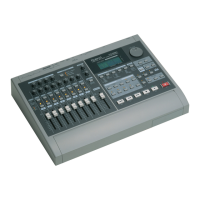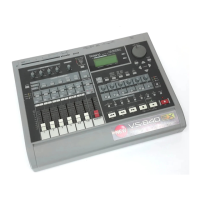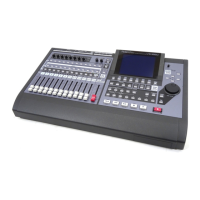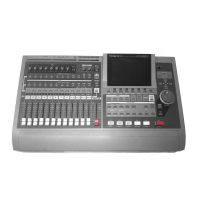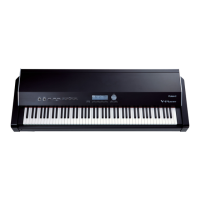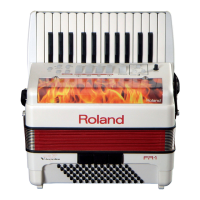21
Chapter 2: Understanding Your VS-880EX
Dynamic Microphone Level -50 dBm
Condenser Microphone Level -30 dBm
HI FI Line Level -10 dBV
Professional Line Level + 4 dBm
0 dBm = 0.775 Vrms, 0 dBV = 1 Vrms
These are nominal levels for reference only. In actual usage, microphones and other
audio equipment exhibit a very wide dynamic (level) range. The important thing to
remember is that all audio equipment operates at some internal “nominal” level. If,
for example, you feed a very high level signal into an input designed for a low level
signal, the input will distort (you “overdrive” the input). Conversely, if you feed an
extremely low level signal into an input designed for a high level signal, you will
add noise to the audio signal.
The VS-880EX uses “variable” level inputs. This allows you to send a wide range of signal levels into the
VS-880EX without distortion or noise. The INPUT SENS (input sensitivity) knobs in the upper left corner
of the front panel control the variable inputs.
When they are set to -50, it means that they are set to receive a nominal level of -50 dBm (dynamic
microphone). Conversely, when they are set to +4, they should receive an input level of approx. + 4 dBm.
The “nominal” operating level of the VS-880EX is -10 dBV.
A Mixer Analogy
To best understand the concepts of signal flow, let’s think about the plumbing in your own home and use it
to illustrate the signal flow in the VS-880EX mixer.
Think of your home as the VS-880EX mixer. The cold water coming into your home from the main supply
in the street is just like the audio signal from your guitar entering an input of the VS-880EX. As shown in
the plumbing diagram, the cold water branches into two directions, the kitchen sink and your water
heater. The same thing can happen in the VS-880EX. The guitar signal can be sent to a reverb device (water
heater) and a recording track (kitchen sink) simultaneously.
The water (guitar) that has passed through the water heater (reverb) is now very hot (has lots of reverb).
The original cold water (dry guitar) travels to the kitchen sink (recording track) by one path and the hot
water (reverb guitar) travels to the kitchen sink (recording track) by a different path or pipe.
We have faucets (faders) at the kitchen sink that can control the mix of cold and hot water entering the
sink. Just like a fader or volume control in the VS-880EX controls how much dry guitar and how much
reverb guitar are mixed together and sent on to the drain (output).
Once the cold and hot water are mixed in the kitchen sink, they become warm water which flows out the
drain to the street (output).
Whenever you want to visualize the signal flow in your VS-880EX, think about the water flow in your own
home. If you can always think about “where is the signal coming from” and “where is the signal going
next,” you should not have any difficulty navigating the mixer in your VS-880EX.

